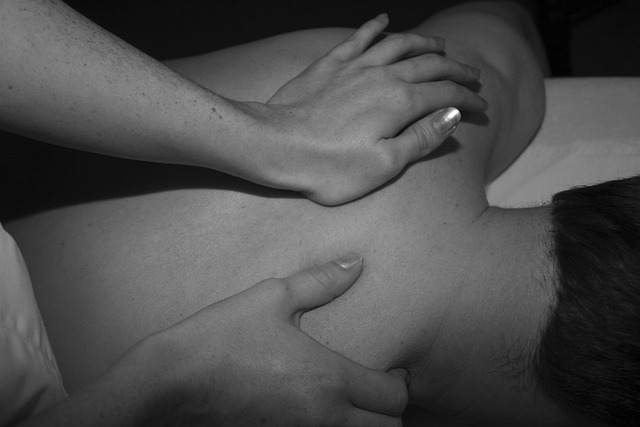Infrared light therapy (IRT), also known as red light therapy, is a non-invasive treatment that utilizes specific wavelengths of light to stimulate cellular repair and enhance physiological processes. It works by penetrating the skin to interact with chromophores, triggering biochemical reactions that increase oxygenation, promote collagen production, and reduce inflammation. IRT accelerates muscle recovery, reduces pain, and supports tissue repair, making it a popular choice for athletes and those seeking natural remedies for muscle-related issues. By improving circulation and oxygen delivery to sore or injured tissues, IRT speeds up healing, reduces inflammation, and promotes faster recovery from workouts or injuries, offering a drug-free alternative with minimal side effects.
“Uncover the transformative potential of red light therapy, a cutting-edge approach to enhancing circulation and oxygen delivery. This innovative treatment leverages the power of infrared light to stimulate blood flow, ensuring optimal nutrient and oxygen supply to muscles. By delving into the science behind this method, we explore how it accelerates muscle healing. From understanding its mechanism to uncovering its safety and efficacy for treating muscular disorders, this article is your guide to harnessing the benefits of infrared light therapy for muscle healing.”
Understanding Red Light Therapy: Unlocking the Power of Infrared
Red Light Therapy, also known as low-level laser therapy or photobiomodulation, is a non-invasive treatment that utilizes specific wavelengths of light, particularly infrared light, to stimulate cellular repair and enhance various physiological processes in the body. This innovative approach has gained traction in the wellness industry due to its potential benefits for muscle healing and overall health.
Infrared light therapy for muscle healing works by penetrating the skin’s layers and interacting with chromophores, such as cytochromes and melanin, within cells. This interaction triggers a series of biochemical reactions, increasing cellular oxygenation, promoting collagen production, and reducing inflammation. By improving circulation and enhancing oxygen delivery to tissues, red light therapy accelerates muscle recovery, reduces pain, and supports tissue repair, making it an increasingly popular choice for athletes and individuals seeking natural remedies for muscle-related ailments.
How Red Light Therapy Enhances Blood Flow and Oxygen Distribution
Red light therapy, also known as infrared light therapy, has been shown to significantly enhance blood flow and oxygen distribution within the body. This non-invasive treatment works by emitting low-level infrared radiation that penetrates deep into the skin’s layers, stimulating mitochondria—the powerhouses of cells—to produce more ATP (adenosine triphosphate), the primary source of energy for bodily functions. As a result, blood vessels dilate, promoting increased circulation and ensuring that oxygen-rich blood reaches every cell, tissue, and muscle efficiently.
This improved oxygen distribution is particularly beneficial for muscle healing and recovery. By increasing oxygen availability at the site of injury or strain, red light therapy accelerates the repair process, reduces inflammation, and supports the growth of new, healthy cells. Moreover, enhanced circulation promotes the removal of metabolic waste products and toxins from muscles, further facilitating faster healing and reducing post-exercise soreness. Thus, infrared light therapy emerges as a powerful tool in both athletic performance enhancement and injury rehabilitation.
Benefits of Improved Circulation and Oxygen Delivery for Muscle Healing
Improved circulation and oxygen delivery, thanks to red or infrared light therapy, are significant benefits for muscle healing. When muscles receive a steady stream of rich, oxygenated blood, it accelerates repair processes and reduces inflammation. This is particularly beneficial for athletes, fitness enthusiasts, and anyone recovering from injuries, as it helps in the restoration of damaged muscle fibers and speeds up rehabilitation.
Infrared light therapy for muscle healing promotes vasodilation, widening blood vessels to facilitate better circulation. As a result, nutrients and oxygen are delivered more efficiently to the muscles, enhancing their ability to recover and perform optimally. This non-invasive approach can be a game-changer in managing muscle soreness, stiffness, and post-workout recovery, allowing individuals to push their physical limits with reduced risk of injury.
Safety and Effective Use of Red Light Therapy for Muscular Disorders
Red light therapy, also known as infrared light therapy, has gained popularity for its potential benefits in muscle healing and recovery. When used for muscular disorders, this non-invasive treatment offers a safe and effective approach to enhancing circulation and promoting oxygen delivery to sore or injured tissues. The low-level light energy penetrates the skin, stimulating blood flow and encouraging the body’s natural healing processes.
This therapy is particularly beneficial for athletes, fitness enthusiasts, and individuals suffering from chronic muscular pain. By increasing blood circulation, red light therapy can help reduce inflammation, speed up recovery after intense workouts or injuries, and alleviate muscle stiffness. It provides a drug-free alternative with minimal side effects, making it an attractive option for those seeking natural remedies for muscular disorders.
Red light therapy, through its ability to penetrate deep into tissues with infrared light, has been shown to significantly boost circulation and oxygen delivery. This non-invasive approach enhances blood flow, aiding in faster muscle recovery and repair, particularly in cases of muscular disorders. By understanding how red light therapy works and adhering to safe usage practices, individuals can harness the power of infrared light for optimal muscle healing. Incorporating this innovative technique into wellness routines could very well be a game-changer for those seeking natural remedies for muscle-related issues.
